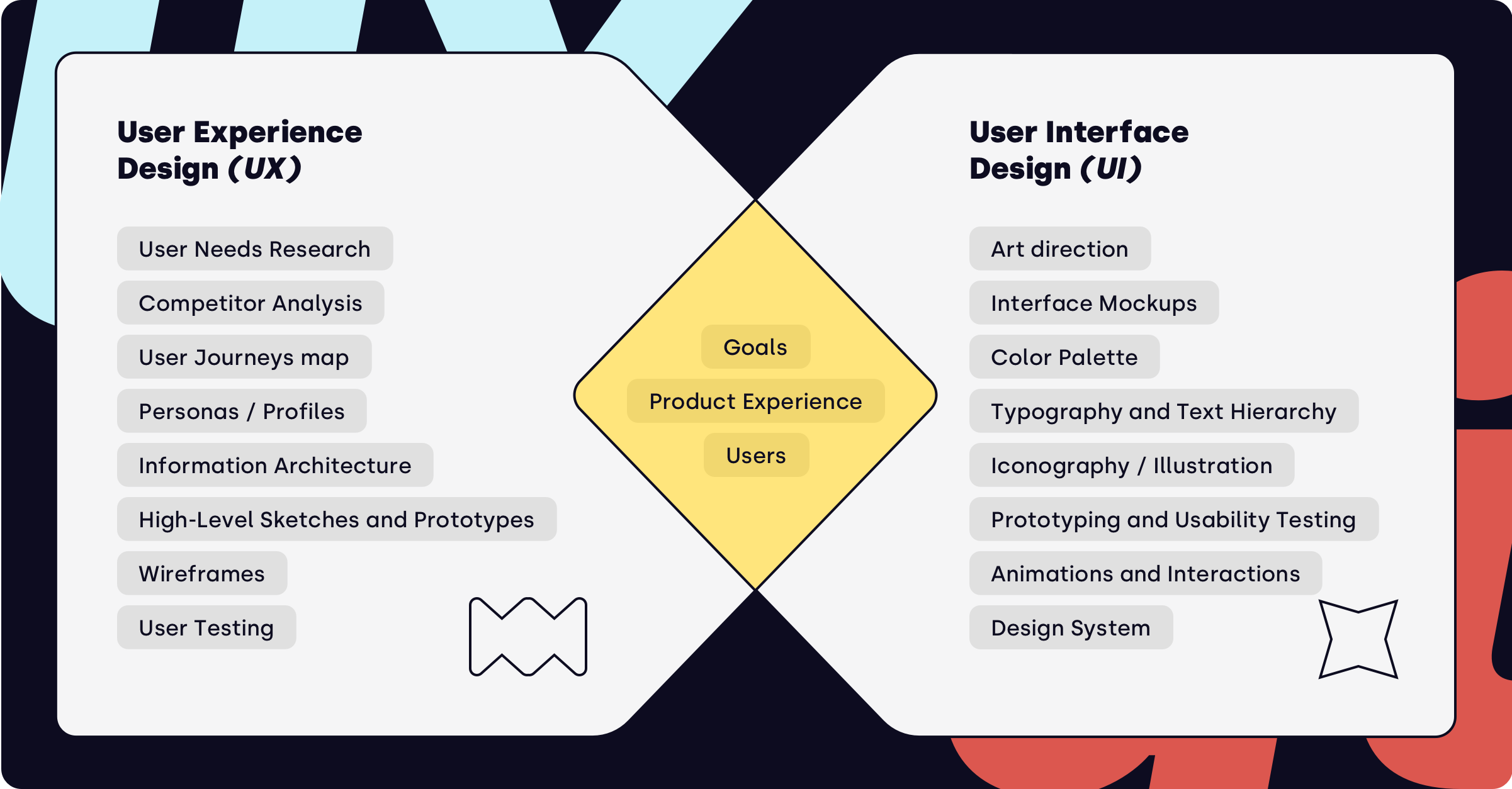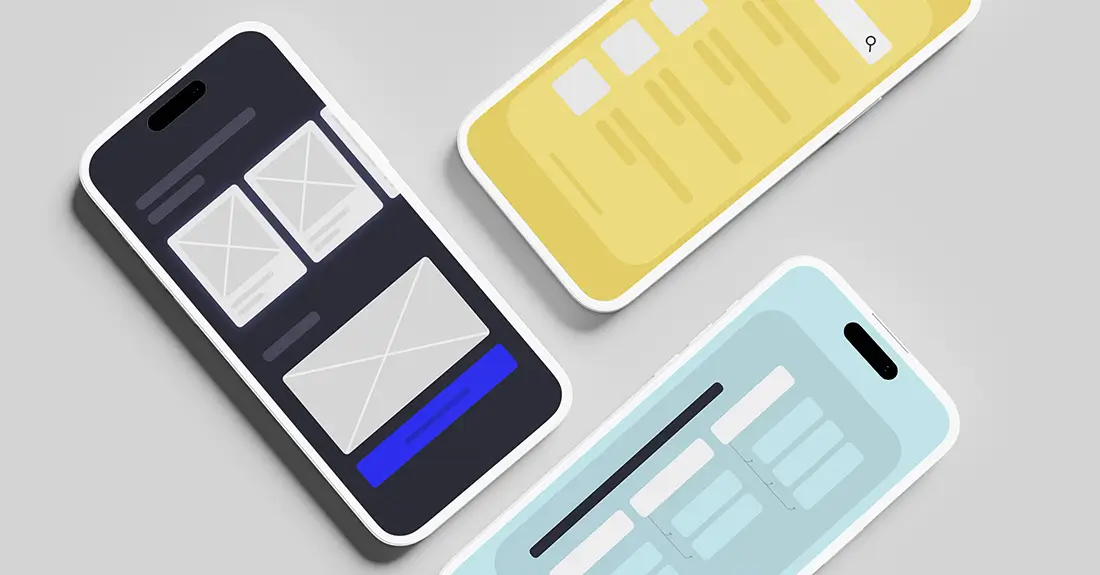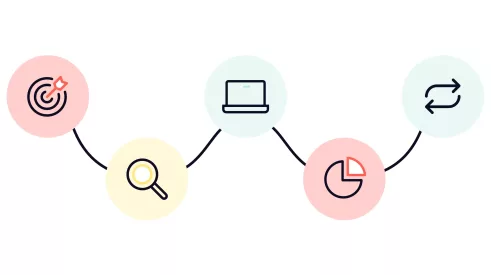Optimize the quality of your product experience and for your users with UX Design (User Experience Design in english, Design de l’expérience utilisateur in french)
User Experience (UX) design is a creative process aimed at understanding and anticipating user behaviors through research, interviews, hypotheses, and testing. This process helps design a seamless and smooth experience across various digital products (mobile applications, web design, websites, software, e-commerce) to ensure user satisfaction.
You can rely on the UX designer for their expertise in data analysis, empathy towards the target audience, and structured approach to ensure uniformity in the desired experience. With their expertise, the UX designer will help you visualize your ideas and the specific needs of your users schematically, often using wireframes, thus translating requirements into practical and effective solutions.
The difference between UX Design and UI Design
These two concepts are often mixed up, but they have well-defined and complementary responsibilities.

UX / User Experience Design
- Researching user needs
- Competitor analysis
- Defining the user journey
- Personas / profiles
- Information architecture
- Wireframes / High-level prototypes
- Ergonomic testing / User testing
- At the UX design stage, we ensure a solid product skeleton that meets user objectives.
UI / User Interface Design
- Refining features
- Artistic direction / Moodboard / Typography
- Graphic mockups
- Iconography / Illustration
- Animations and interactions
- Prototyping and ergonomics testing
- Webmaster recommendations (SEO, loading speed, image compression)
- Design system
- At the UI design stage, we ensure a visually coherent final product that is adapted to the users.
Learn more about UI (User Interface Design). 👈
Key elements to ensure the best user experience
Define the design process
Creating a roadmap with clear steps will help throughout the project. At the beginning, setting up key moments to define and interview our users will guide us at each stage. It is crucial to hear their perspective even before defining the features to ensure a high conversion rate. Iterations and tests with users in both UX and UI design will allow us to obtain precise feedback throughout the project and remain alert to their actual needs.
Conduct user research
From the early stages of a project, it is recommended to create personas that will be used as a reference by all team members (internal and client) until delivery. Personas are detailed, fictional representations of target users, created to guide the design and development of the product based on real data. These personas will guide us in finding future users of the product, allowing us to find individuals who match and can be interviewed during the user research phase. These interviews will collect firsthand information and define the product’s added value to meet user needs.
Create the user journey
The user journey is a visual representation of the steps and interactions a user goes through to accomplish a specific task within a digital product or service. Mapping this journey helps identify potential friction points and opportunities for improvement, ensuring a smooth and satisfying experience. By understanding each step of the journey, designers can optimize the interface and features to meet users’ needs and expectations at every touchpoint.
Competitive analysis
Using search engines, we can also analyze patterns to identify trends and common practices, like those employed by digital giants (e.g., Apple). This research helps position our product by comparing its features with competitors and identifying what makes it unique.
Information architecture
Before considering the product’s layout, it is important to structure the information, which is where information architecture comes in. It involves organizing and structuring the content of a digital product in a logical and intuitive way, facilitating navigation and understanding for the user. Good information architecture helps prioritize content, create clear navigation paths, and make interaction with the product smoother and more efficient. By clearly defining categories, subcategories, and the relationships between different content elements, users can quickly and easily find what they are looking for.
Wireframes and prototyping
Wireframes are low-fidelity mockups that illustrate the sequence of elements on each page or screen. They are useful early in the interface design process. Unlike graphic mockups, wireframes do not include brand-specific visual choices and do not reflect the final appearance of the product.
Prototypes, on the other hand, offer an interactive version of the product, allowing for testing and refining the user experience in near-real conditions. They can be created at various points during a project to confirm a hypothesis we have during the mandate. Wire framing and prototyping are crucial steps in the design process, allowing for the validation of the product’s usability before entering development phases, ensuring that the product’s structure and features meet user expectations.
Conclusion
When designing a digital interface, it is essential to always keep the end user in mind. By integrating UX and UI design principles and using the techniques mentioned above, we can create products that are not only aesthetic but also intuitive and effective. A user-centered approach ensures that every design decision contributes to an optimal experience, meeting users’ needs and expectations while achieving the product’s objectives.





